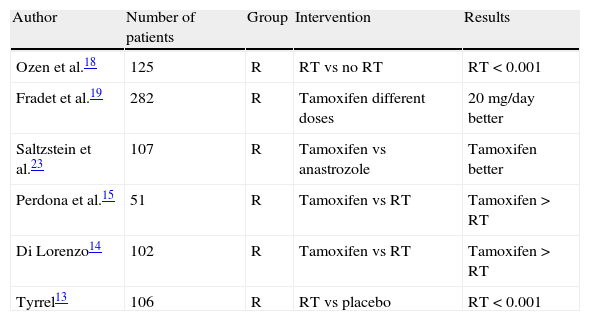Gynecomastia, defined as benign proliferation of glandular breast tissue has a prevalence of 32–72% in the male. In the urology setting, it is associated to patients with prostate cancer and hormone treatment with a prevalence of 15% in the case of complete hormone blockage and 75% in monotherapy. The different options of treatment in prostate cancer have changed in recent decades. Thus, we have focused on this subject to evaluate the different therapy options of hormone manipulation induced gynecomastia in prostate cancer patients.
ObjectiveTo synthesize the available evidence on the different therapeutic options in prostate cancer patients who develop gynecomastia due to the use of nonsteroidal antiandrogens and to generate a diagnostic algorithm and treatment.
Acquisition of evidenceUsing the PICO type structured search strategy (patient or problem, intervention, comparison, outcome or result) in the data bases of PubMed-Medline and Cochrane, identification was made of the relevant studies related to the treatment of gynecomastia in prostate cancer patients treated with nonsteroidal antiandrogens.
Synthesis of evidenceWe have found 3 possible therapeutic options for the treatment of gynecomastia and mastodynia in patients with hormone deprivation therapy for prostate cancer. The 10Gy radiotherapy would be an option for the treatment of gynecomastia, although not all the patients need prophylactic treatment since only 50% report moderate–severe discomfort. Another option is the use of drugs such as tamoxifen 20mg/day that lead to a significant decrease in the mammary effects.
ConclusionsGynecomastia and mastodynia, given their high incidence, make the physical examination a fundamental tool for all patients before initiating treatment with antiandrogens. The use of tamoxifen 20mg/day is the best treatment and prevention option against gynecomastia and mastodynia, while in the case of long-course established gynecomastia, surgery is the gold standard.
La ginecomastia, definida como una proliferación benigna de tejido glandular mamario, se presenta en el varón con una prevalencia entre el 32–72%. En el ámbito de la Urología se asocia a pacientes con cáncer de próstata y tratamiento hormonal, con una prevalencia del 15% en el caso de bloqueo hormonal completo y del 75% en monoterapia. Las diferentes opciones de tratamiento del cáncer de próstata han cambiado en las últimas décadas. Es por este motivo por lo que nos centramos en este tema para valorar las diferentes opciones terapéuticas de la ginecomastia causada por la manipulación hormonal en pacientes con cáncer de próstata.
ObjetivoSintetizar la evidencia disponible sobre las diferentes opciones terapéuticas en pacientes con cáncer de próstata que desarrollan ginecomastia por el uso de antiandrógenos no esteroideos, y generar un algoritmo de diagnóstico y tratamiento.
Adquisición de evidenciaMediante el uso de estrategia de búsqueda estructurada tipo paciente problema, intervención, comparación, outcome o resultado (PICO) en la base de datos de PubMed-Medline y de la Cochrane se llevó a cabo la identificación de estudios relevantes relacionados con el manejo de la ginecomastia en pacientes con CaP tratados con antiandrógenos no esteroideos.
Síntesis de evidenciaNos encontramos con 3 posibles opciones terapéuticas para el manejo de la ginecomastia y la mastodinia en pacientes que realizan tratamientos de deprivación hormonal para el cáncer de próstata. La radioterapia 10Gy sería una opción para el tratamiento de la ginecomastia, aunque no todos los pacientes necesitan un tratamiento profiláctico, ya que solo el 50% refieren molestias moderadas-severas. Otra opción es el empleo de fármacos como tamoxifeno 20mg/d que ocasiona una disminución importante de los efectos mamarios.
ConclusionesLa ginecomastia y la mastodinia, dada su alta incidencia, hacen que la exploración física sea un arma fundamental para todos los pacientes antes de iniciar un tratamiento con antiandrógenos. El empleo de tamoxifeno 20mg/d constituye la mejor opción para el tratamiento y la prevención de la ginecomastia y la mastodinia, mientras que en el caso de la ginecomastia establecida de larga evolución la cirugía es el patrón de oro.










